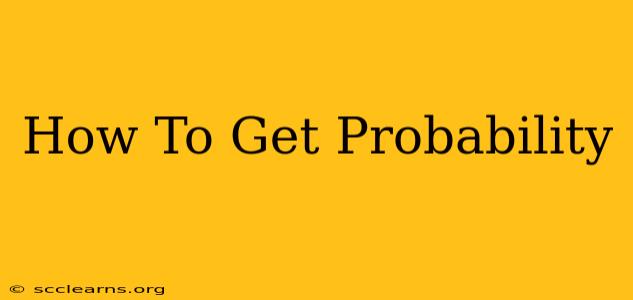Understanding probability is crucial in many aspects of life, from making informed decisions to analyzing data. Whether you're a student tackling a statistics problem or a professional needing to assess risk, grasping the fundamentals of probability is essential. This comprehensive guide will walk you through the core concepts and provide practical examples to help you master this important subject.
What is Probability?
Probability, at its simplest, is the chance of an event happening. It's expressed as a number between 0 and 1, inclusive. A probability of 0 means the event is impossible, while a probability of 1 means the event is certain. Values in between represent varying degrees of likelihood. For example:
- Probability of 0: The sun rising in the west.
- Probability of 1: The sun rising in the east (assuming a normal day).
- Probability of 0.5: Flipping a fair coin and getting heads.
Calculating Probability: The Basics
The fundamental formula for calculating probability is:
Probability (Event) = (Number of Favorable Outcomes) / (Total Number of Possible Outcomes)
Let's illustrate with a simple example: What's the probability of rolling a 3 on a six-sided die?
- Number of Favorable Outcomes: 1 (only one face shows a 3)
- Total Number of Possible Outcomes: 6 (six faces in total)
Therefore, the probability of rolling a 3 is 1/6, or approximately 0.167.
Types of Probability
Several different approaches exist to determine probability:
1. Theoretical Probability:
This method uses logic and reasoning to determine the likelihood of an event. We use this approach in the die example above. It assumes a fair die (each side has an equal chance of appearing).
2. Experimental Probability:
This involves conducting experiments or observing real-world events to estimate probability. For instance, if you flip a coin 100 times and get heads 48 times, the experimental probability of getting heads is 48/100, or 0.48. Experimental probability is often used when theoretical probability is difficult to determine.
3. Subjective Probability:
This type of probability is based on personal judgment or belief. It's used when there's limited data or objective information available. For example, an expert might estimate the probability of a new product succeeding in the market based on their experience and knowledge.
Advanced Probability Concepts
As you progress, you'll encounter more advanced concepts, including:
-
Conditional Probability: The probability of an event happening given that another event has already occurred. For example, what is the probability of drawing a king from a deck of cards given that the first card drawn was a queen (and was not replaced)?
-
Independent Events: Events where the outcome of one event doesn't affect the outcome of another. Flipping a coin multiple times are independent events.
-
Dependent Events: Events where the outcome of one event does affect the outcome of another. The card example above illustrates dependent events.
-
Bayes' Theorem: A mathematical formula used to calculate conditional probabilities. It's particularly useful in updating beliefs based on new evidence.
Applying Probability in Real-World Scenarios
Probability is used extensively across various fields, including:
- Finance: Assessing investment risks and returns.
- Insurance: Calculating premiums and payouts.
- Medicine: Diagnosing diseases and evaluating treatment effectiveness.
- Weather Forecasting: Predicting the likelihood of different weather events.
- Gaming: Determining the odds in games of chance.
Mastering Probability: Practice Makes Perfect!
The key to mastering probability is practice. Work through numerous examples, solve problems, and gradually tackle more complex scenarios. Use online resources, textbooks, and practice problems to build your understanding. Remember, consistency and persistent effort are vital to achieving proficiency in probability. The more you practice, the more intuitive the calculations will become, helping you confidently approach any probabilistic challenge.

